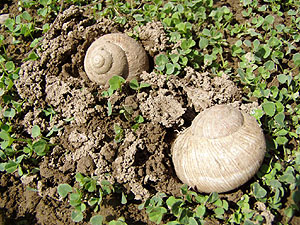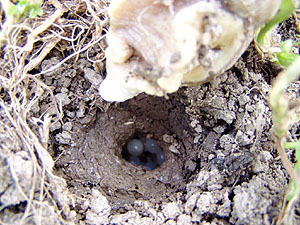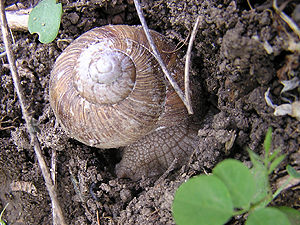
It may happen but weeks after mating, that a Roman snail
deposits its eggs, provided the conditions are favourable.
Picture: Monika Samland.
 It may happen but weeks after mating, that a Roman snail deposits its eggs, provided the conditions are favourable. Picture: Monika Samland. |
 A view into a Roman snail's hatchery hole. Picture: Monika Samland. |
To find a suitable place to deposit their eggs, about 4 to 6 weeks after mating, Romans snails sometimes migrate for noticeable distances. To make a hiding place for its eggs, the snail needs at least 3 to 5 cm of loose ground to dig a hole in. The hole, in which the eggs are to be placed, resembles that a Roman snail usually hibernates in. So this hole as well the Roman snail digs with its foot, helping with drilling motions of the shell. Not all holes begun will be used as a hatchery in the end; often a snail will leave one digging place to start somewhere else again.
Only when it is finished digging a suitable hole for its eggs, the Roman snail will take a break of several hours, during which it will stay at the hole and begin to fertilise the egg cells and to produce eggs in the spermoviduct.
Laying eggs is a mechanical process the snail cannot stop, once it has begun. Should it be disturbed, the snail will probably leave the site and in the meantime continue laying its eggs on the ground, where they will most probably be lost.
 Picture: [RN]. |
The Roman snail deposits an egg of about 6 mm diameter (0.1 to 0.2 g weight) each 15 to 30 minutes.
As the amount of eggs laid by a Roman snail may vary with age and locality, counting 40 to 60 eggs, the process of egg deposition may last between 20 and 30 hours!
When it has finished, the snail withdraws its body from the egg hole and glides over the opening to close it with earth crumbs. In the egg hole now closed the development of the young takes place without any further interference of the adult snail.
Snails do not watch over their young. The only molluscs that do, are octopuses, which are among the most highly developed molluscs.